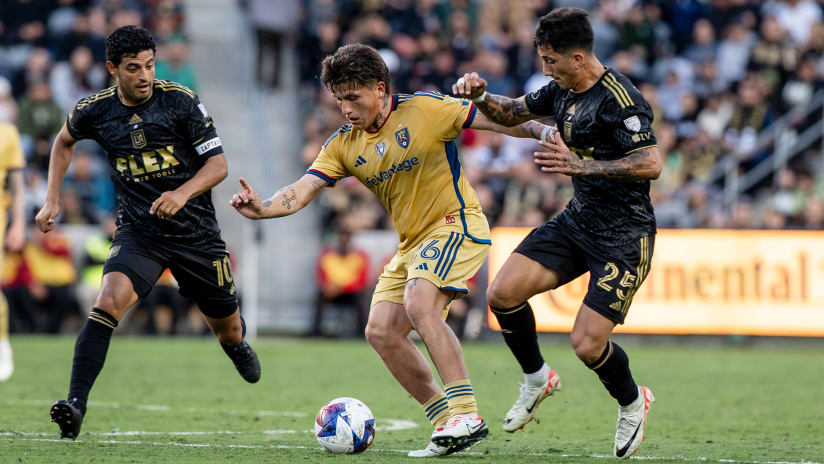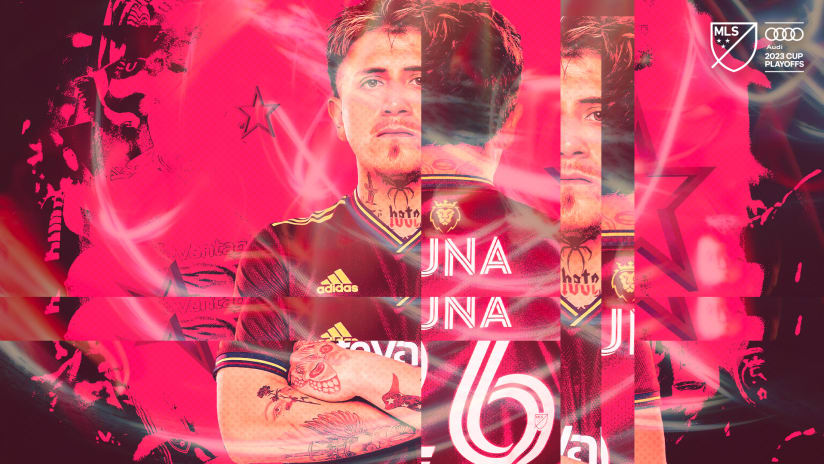Diego Luna’s parents might not have known exactly what they were signing on for. But that’s water under the bridge at this point.
When you watch Real Salt Lake’s young attacker play, you may notice his creativity, his dynamism, his scurrying work rate. On first viewing, you’ll probably take note of his well-inked skin, too, and perhaps ponder how someone could accumulate so many tattoos in just 20 years of life.
The answer to that is actually more useful than you might think. It can begin to sketch the outlines of Luna’s uncommon soccer journey, of his strong roots in the game, and his decision to remove himself from them, at least geographically. And of the remarkable growth that’s made him perhaps the most important player on a trophy-chasing team despite his relatively tender age.
“It was always just an artistic thing and something that I enjoyed. I just like it,” Luna told MLSsoccer.com in a wide-ranging conversation this week. “I like how they look, and it might sound a little weird, but I've learned to use them as kind of therapy.”
Luna is the person and player he is because of his family. The youngest of four siblings, he grew up in a soccer-mad household in the San Jose, California suburb of Sunnyvale. Diego’s father Alberto was a professional player back in the 1980s, playing for the pre-MLS Earthquakes, indoor’s San Diego Sockers and Milwaukee Wave among others before moving into coaching. His older brothers Armando and Gio, and later his big sister Kristal, followed dad into the coaching world.
So Diego spent lots of time on and around a soccer pitch as a child. Lots and lots.
“We weren't the wealthiest family, we came from not a lot of money. So we all lived in an apartment together, me and my brother and my sister, my oldest brother lived in a city nearby. And it was kind of just school, and after school, I was at the soccer field from 3:30 pm to around 8:30 pm, because my dad and my whole family coaches,” he explained.
“My training was at 7 pm. So I would go be there for their first training, from 4 pm, and I would stay there and be on the field all day until my training at 7 pm with my team, and then after that head home, dinner and then start the day over again.”
Betting on yourself
Ball is, and always has been, life in the Luna family, and it’s not hard to see the legacy of that in Diego’s style and technique.
“I think it comes with having the ball at my feet five hours a day, where I'm just like, roaming around, talking to people and waiting for my training, but the ball’s at my feet,” he said. “So it's just building that mind-to-foot ratio where you just know where the ball is, you don't have to look. You’re kind of just playing with it, doing little tricks and stuff. So I think it definitely helped me and definitely built my style of play.”
It’s hard to imagine a more optimal environment in which a young player could hone the fundamentals, and his talent did not go unnoticed. Luna earned a spot in the San Jose Earthquakes’ academy and began getting US youth national team call-ups at the Under-14 level.
It’s similarly hard to imagine why, at just 15, he would decide he needed to leave all that behind.
“I felt stuck. I felt like I wasn't improving,” he recalled. “My dream was always to play professional. I wasn't going to go to college, I wasn't going to do something else, it was going to play soccer. And I think I took the big risk of leaving home at 15 and went to Arizona.”
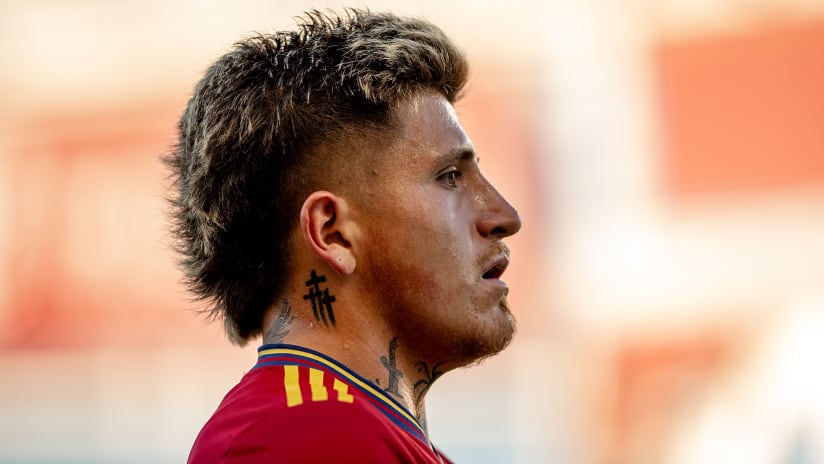
Casa Grande, specifically, the small, remote town halfway between Phoenix and Tucson that is the home of Barça Residency Academy USA, an immersive development program affiliated with Spanish superclub FC Barcelona which has produced a growing list of pros like Julián Araujo, Matthew Hoppe and Caden Clark. (Ironically, RSL once operated their own residential program there as well.)
Luna had scored a goal for his Quakes team in a U.S. Soccer Development Academy match vs. Barça AZ, and one of the latter’s directors took notice. Conversations ensued, and when Luna visited the campus, he knew right away that this was the next step he needed.
“I went out there for three days, I think it was on a Wednesday,” he said. “Came back Friday, and moved there Sunday.”
Barça AZ offered him a full scholarship and access to an environment that he and they believed could push him closer to his best. His parents were taken aback, but eventually signed off.
“It was a very difficult decision. Coming from a Latino background,” said Luna, “you stay with your family and you're there and they help you and everyone helps each other there. So leaving my family at that young age was hard on my mom, especially … It's like, it's not a joke anymore. You have to do this, because you're taking a big risk.”
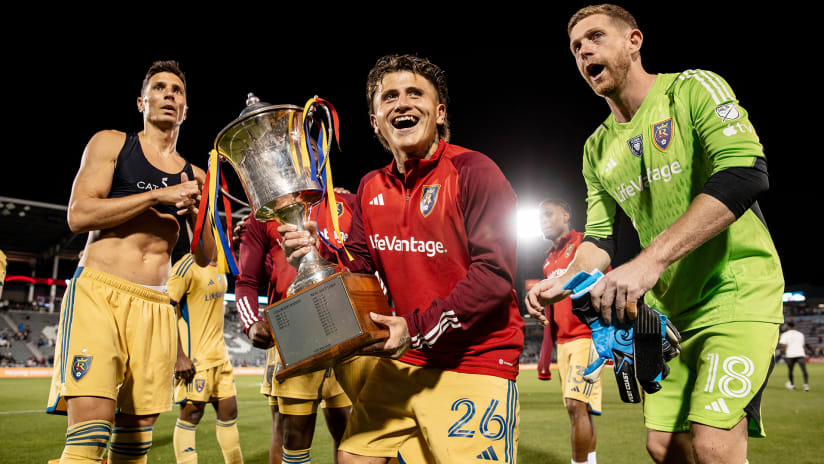
Therapy through ink
As much as he’d gained from those family ties and the common thread of soccer that ran through them, Diego felt he needed to commit to his dreams, even at a cost. Quiet Casa Grande offered a clear pathway, and few distractions – “strictly business,” in Luna’s words.
“You're not there to mess around, you're not there to slack off,” he explained. “You got to commit because, one, you're leaving your family, you're leaving everything and two, you're throwing your social life away, in a sense. You're throwing the high school experience, you're throwing the parties, are throwing whatever you want to say, away.
“It's strictly soccer, strictly academics. And if you're not there to do what you're meant to do, then you're wasting your time. And it shows – the percentage of people coming out of that academy, going pro, getting scholarships, it shows. Once you commit to that you're gonna come out with some sort of success, whether that be pro, whether that be college.”
Which brings us back to Luna’s rich palette of tattoos. It all started with one simple design – a cross and a date on his forearm.
Inevitably, Diego missed his loved ones back in California, and was particularly pained to be nearly 800 miles from home when his brother welcomed a daughter, the first member of the family’s next generation, into the world. So Diego convinced his mom and dad to sign off on his first ink, centered on his niece’s birth date, when they visited him in Arizona.
“The guy who did my tattoo – they signed the waiver and everything, right, and my parents left,” Luna recounted. “He was like yeah, since your parents already signed your waiver, they don't have to be here anymore for the tattoos you get. Like, they basically signed you up. So I was like, oh really?”
So began a tattoo habit that rapidly grew into something both aesthetic and therapeutic, as the buzz of the machine and the fleeting pain it inflicts helped him manage the feelings of separation and stress that sometimes piled up atop all the other powerful emotions of teenage life.
“It relaxes me. It kind of takes out all the anger and the emotions and the sadness and stuff in me, it kind of takes it out on the needle. As weird as it sounds, it works,” he said.
“That's something that I've used and it's helped me. Whenever I'm feeling really down or really angry and stressful, sometimes I go get a nice little tattoo that might not have meaning. But in that moment it's relieving everything from me and it's helping me in a big way. Because then I feel free and I feel open and I leave that tattoo shop feeling like OK, I'm good.”
When he scores goals, Luna kisses that very first tattoo, and the one that inscribes the name of his mother, Susana, on his wrist.
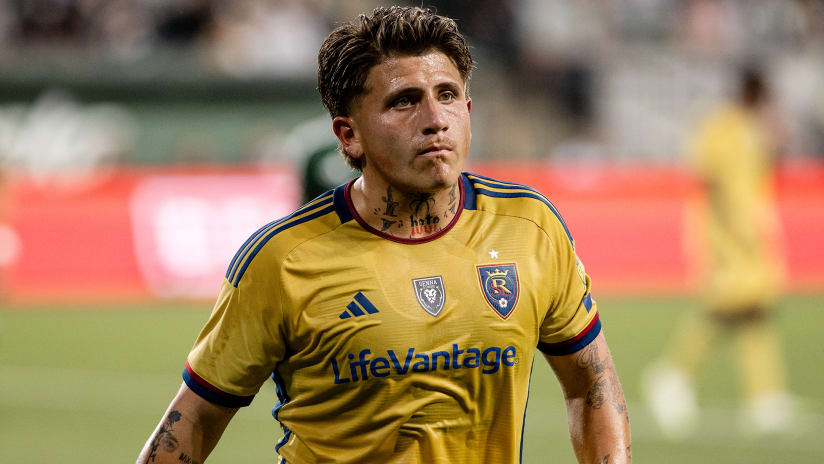
USL to RSL
As his ink multiplied, so did the interest from professional clubs. With Luna prospering in Casa Grande and well entrenched in the US U-20 national team’s player pool, USL Championship clubs New Mexico United and El Paso Locomotive FC, as well as Atlanta United, his hometown Quakes and other MLS sides sought to recruit him.
Here again, the teenager would show perspective beyond his years.
“I needed another step. So I’m climbing up the stairway, right? And I thought going into an MLS team, if they put me on that second team on their second division, I didn't feel like it would have been a change from the academy level I was playing at,” he said. “Just like Barça, I went to El Paso for three days, trained there twice, came back and before even leaving – while I was at the airport in El Paso – I told my family, this is where I want to be. I want to come here, this is where I want to grow. This is where I want to take my next step.”
Luna credits Mark Lowry, Locomotive’s head coach when he arrived in 2021, for helping him maintain his upward trajectory as he quickly became one of the second-division league’s top attackers, scoring nine goals and five assists in his first USL Championship campaign. With Luna looking like a lock for a leading role in the United States’ 2023 U-20 World Cup cycle, suitors flocked both from within MLS and abroad.
RSL would win that race in June of last year, paying El Paso a reported $250,000 transfer fee which marked a new record for USL-to-MLS transactions as well as $50,000 in allocation money to the Earthquakes to acquire his homegrown rights.
As solid as Salt Lake’s youth-development credentials are, this move raised some eyebrows. The track record of the Claret-and-Cobalt’s no-nonsense head coach Pablo Mastroeni suggests a defensive bent and a trust in veterans. How would he handle this undersized creative maverick who was set to be called away from his club for weeks at a time by the US U-20s?
Early returns were not particularly promising. Luna played just 310 MLS minutes (13 matches, three starts) last season, with zero goals and assists, as he shuttled back and forth to international duty and struggled to settle in another new location.
“That was the most difficult jump I've had in my career so far,” he said. “It was a very difficult first six months with RSL. That half of the season that I was here, I didn't score any goals, I didn't get any assists. It was a difficult place mentally where I had to deal with, wow, OK, what's going on now? What do I have to do to stay positive? I'm farther from my family, I'm in another state and I have all these things going on.”
Luna had to come to grips with his best role in RSL’s default 4-4-2 formation under Mastroeni, and his responsibilities therein. A young talent known for creative grace had to prove that he could grind, too.
“I'm a 10, I've always been playing as a 10, I had a free role as a 10. So I was like OK, here I have to integrate myself into a position, I have to learn a new formation,” said Luna. “Because I never played a 4-4-2 flat with the national team, with the clubs I'd played for. It was always 4-3-3, 3-5-2, something like that. So it was learning how to play a new position, learning where I could integrate myself, where I could fit into this formation. I tried the pivot, I tried up top, I tried left wing. So it took a while.”
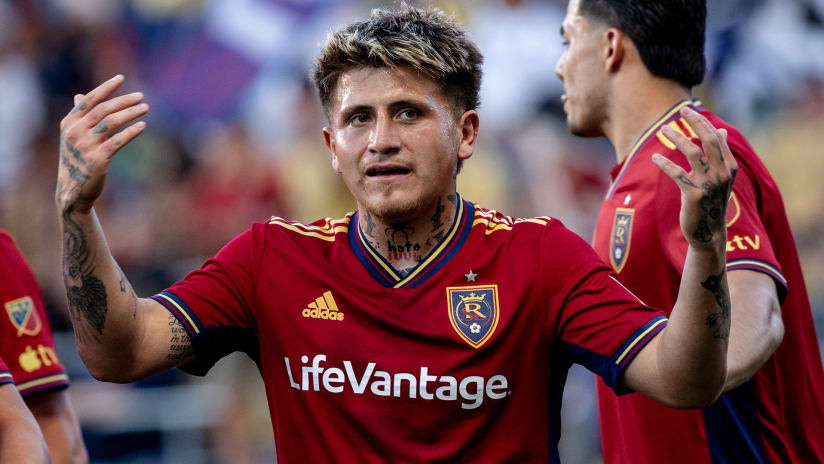
Finding a balance
Before jetting off to the U-20 World Cup in May, his handful of substitute appearances in the opening months of the 2023 season added up to barely 90 league minutes in total. Then, after catching the eye of scouts around the world as he helped the US reach the quarterfinals of the tournament in Argentina, everything began to click on his return.
First he earned a starting spot on the left side of midfield. Then he consolidated it with a 1g/2a performance in a head-turning 3-1 road win over Western Conference frontrunners St. Louis CITY SC. A few weeks later he bagged a brace in a win over the New York Red Bulls. Even when end product like that wasn’t rolling in every weekend, Mastroeni was won over by the comprehensiveness of Luna’s overall displays.
“Never do we talk about some of the most important things about development – and I’m talking about for all of us, whether you’re a player, or you’re a human being,” said the coach after the RBNY result, proclaiming that “the ceiling is high” for his young prospect. “Going through tough times allows you to evolve in a way that you are a different person than you were before. I think the hardship that Luna went through … put him in a position to dig in a little bit deeper.”
Along that journey from NorCal to Arizona to Texas to Utah, Luna had accumulated the tools he needed to make his next breakthrough.
“I changed my mentality in saying, I need to be an overall great player, on the ball and off the ball. And I think I've shown that within [recent] months,” he told MLSsoccer.com. “I think my defense has gotten extremely better, I think my recoveries and my defensive reactions and stuff have been excellent. I think that's what's given me the opportunity to play and to showcase myself on the attack side, because Pablo trusts me. I’m doing what's needed as a soccer player is to do both sides of the work and on the ball, I can do my freedom and have fun. So I think it's all about finding the balance.”
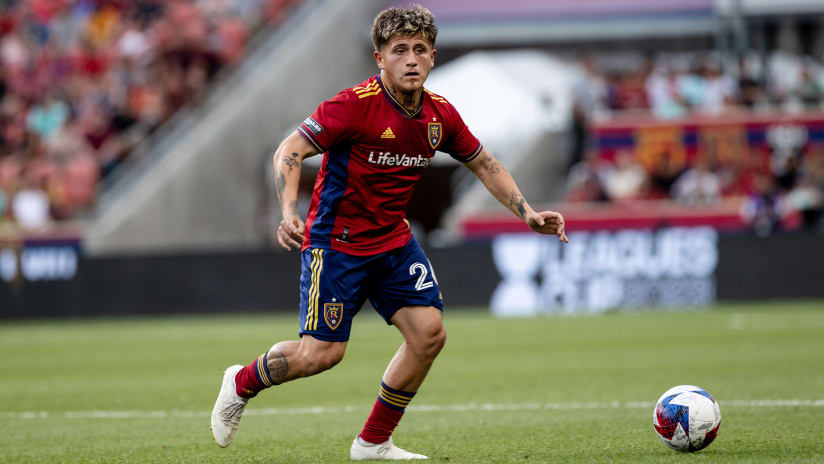
Playing with joy
Luna found a higher gear down the stretch, scoring in both of Salt Lake's final two regular-season games to finish on 5g/3a in 1,201 MLS minutes. And with injury and fitness concerns swirling around other key contributors like Chicho Arango and Jefferson Savarino, the mantle of attacking responsibility may now pass to Luna as RSL chase an MLS Cup.
“It’s really interesting in sport where, if there's a void, right, we don't have Sava, we don't have Chicho, the void will always be filled. And I think he's taken that upon himself to be a guy that's finishing chances,” said Mastroeni after Luna scored the only goal in their Decision Day road win over Colorado.
“That's an area of his game that we've talked about – the middle third of the field, he's fantastic. How can you be dangerous in that final third? And he stays after every day and works on his finishing. And so I think it's not a surprise to us that Diego has now finished in the last two games, and really been a leader, even though he's still a young player. So it's fantastic to watch, and you see his commitment to becoming a great pro.”
Now the kid playfully dubbed “Moon Boy” back in El Paso has a child of his own, as his girlfriend gave birth to their son two months ago. Fatherhood is the next step in Luna’s path, one he’s embracing with faith and hope.
“Having him, there's a different motivation that I didn't know that could that happen,” he said. “When he was born, I think it was something like sort of, like a switch in me, where it kind of just changed everything in my life. Every little thing that I do is thinking about him.
“I leave a lot into God's hands. When things aren't going my way, I kind of relax, I read the Bible, very religious in that way. I kind of just give my hope to God.”
That aforementioned quest for balance has taken Luna to all sorts of unexpected places. Before he signs off, he shares one more tattoo story, about an infamous comic-book villain and his iconic slogan blazoned on his leg which, perhaps counterintuitively, provides him with perspective in moments of stress.
“I love The Joker, I think he's a great character. But it's a deeper meaning,” he explained. “You don't always have to be so serious. Take things as they go.
"When I've played, I realized I don't play good when I'm focused, when I'm serious and when I'm upset, when I'm angry. It's got to be just like, you're blessed to enjoy it, to play soccer as your job. Who else can you say that? You get to go train in the morning, you get to travel, and you get to kick a ball around and run for your job. You can't be stressing on things when you have this amazing job.”
